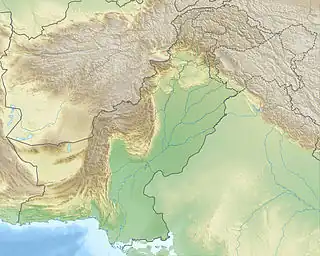| Karot Hydropower Project | |
|---|---|
 Location of Karot Hydropower Project in Pakistan | |
| Official name | Karot Hydropower Project |
| Location | Punjab, Pakistan |
| Coordinates | 33°35′59.29″N 073°36′4.42″E / 33.5998028°N 73.6012278°E |
| Status | Operational |
| Construction began | December 2016 |
| Opening date | June 2022 |
| Construction cost | $1.42 billion |
| Owner(s) | China Three Gorges Corporation (CTG) |
| Dam and spillways | |
| Type of dam | Embankment, rock-fill |
| Impounds | Jhelum River |
| Height | 95.5 m (313 ft) |
| Length | 460 m (1,510 ft) |
| Reservoir | |
| Total capacity | 164.5 million |
| Maximum length | 27 km (17 mi) |
| Normal elevation | 461 m (1,512 ft) |
| Power Station | |
| Commission date | June 2022 |
| Turbines | 4 x 180 MW Francis-type |
| Installed capacity | 720 MW |
| Annual generation | 3,436 GWH |
The Karot Hydropower Project is an asphalt-core rockfill gravity dam in Pakistan, with an installed capacity of 720 MW. The project is sponsored by Chinese state-owned company China Three Gorges Corporation (CTG).
It is the first investment project of the Silk Road Fund, and is part of the much larger China–Pakistan Economic Corridor (CPEC).[1]
The project was successfully commissioned on June 29, 2022.[2]
Location
The Karot Hydropower Project is located on Jhelum River near Karot village, some 1.7 kilometers upstream of Karot Bridge and 74 km upstream of Mangla Dam. The Project site is accessible through the Islamabad – Kahuta – Kotli road, approximately 29 kilometers from Kahuta, and 65 kilometers from Islamabad.
History
The Jhelum River is the largest river of Indus Basin River System, and its hydropower potential was identified by various studies carried out by international agencies, with the first report issued by the Canadian Consultant group MONENCO in 1983, followed by a 1994 study by the German Agency for Technical Cooperation (GTZ) that formally proposed the Karot Hydropower Project.[3]
On September 28, 2016, the federal and Azad Jammu and Kashmir governments signed an implementation agreement with a Chinese consortium for development and operation on river Jhelum at a levelised tariff of 7.57 cents per unit for 30 years. Financial close of the project was achieved in February 2017 while land acquisition was also completed.
Groundbreaking on the project took place on January 10, 2016.[4] The project was successfully commissioned on June 29, 2022.[2]
Project details
The major project features include a 95.5 meters high asphalt-core rockfill gravity dam with a crest length of 320 meters near the village of Gohra.[5] The dam's reservoir is approximately 164.5 million cubic meters in volume, with a length of 27 kilometers.[6][7] 72 homes and 58 businesses are relocated as a result of construction,[8] while 2.8 kilometers of the Karot-Kotli road, and 8.9 kilometers of the Azad Pattan-Kahuta road are also relocated.[9]
The power intake structure is constructed on right bank of the river immediately upstream of Dam site and diverts the water into headrace tunnels entering into Cavern Powerhouse. The water is discharged back to River Jhelum through tail-race channel located at right bank of the River Jhelum immediately downstream of Karot village. The dam generates mean annual energy 3,436 GWh, and is connected to Pakistan's national electricity grid.
SMEC International Pty Ltd is participating as Employer's Engineer, who is providing services for project management, design review and construction supervision for 720 MW Karot hydropower project.
Financing
The Karot project is developed by Karot Power Company comprising Three Gorges South Asia Investment Limited, a subsidiary of China Three Gorges Corporation, China-CTGC and Associated Technologies of Pakistan.
Total cost for the project is estimated to be $2 billion, and is funded by International Finance Corporation, China's Silk Road Fund.[10] The Export-Import Bank of China and China Development Bank issued loans to the Karot Power Company.[11] It is built on a "Build-Own-Operate-Transfer" basis for 30 years, after which ownership will be turned over to the government of Pakistan.[12]
The company will run and maintain the project for 30 years at a levelised tariff of 7.57 cents per unit after which it will be transferred to the Punjab government at a notional price of Rs.1.
References
- ↑ "Q&A about the Silk Road Fund's First Project Investment". April 20, 2015. Archived from the original on February 1, 2018. Retrieved January 31, 2018.
- 1 2 "CPEC's Karot Hydropower Plant put into 'full commercial operation'". The Express Tribune. 2022-07-01. Retrieved 2022-07-01.
- ↑ "Punjab-EPA approves Karot Hydropower Project". Dawn. 2 March 2015. Retrieved 13 March 2016.
- ↑ Tiezzi, Shannon (13 January 2016). "China Powers up Pakistan: The Energy Component of the CPEC". The Diplomat. Retrieved 13 March 2016.
- ↑ "Korot Power Company (Pvt) Ltd ("Company"), Application for Modification of the Generation License of 732 MW Karot Hydropower Project" (PDF). NEPRA. 10 August 2015. Retrieved 13 March 2016.
- ↑ (PDF). Karot Power http://www.karotpower.com/cms/lib/downloadfiles/esia.pdf. Retrieved 13 March 2016.
January 2015
{{cite web}}: Missing or empty|title=(help) - ↑ "Disclosure - Home".
- ↑ (PDF). Karot Power http://www.karotpower.com/cms/lib/downloadfiles/esia.pdf. Retrieved 13 March 2016.
January 2015
{{cite web}}: Missing or empty|title=(help) - ↑ (PDF). Karot Power http://www.karotpower.com/cms/lib/downloadfiles/esia.pdf. Retrieved 13 March 2016.
January 2015
{{cite web}}: Missing or empty|title=(help) - ↑ Poon, Daniel (8 December 2015). "China's partnerships could lead the way". Asia and the Pacific Policy Society. Retrieved 11 December 2015.
- ↑ Ingram, Elizabeth (30 April 2015). "Karot in Pakistan to be first hydropower project financed by China's Silk Road Fund". Hydroworld. Retrieved 13 March 2016.
- ↑ "Karot in Pakistan To Be First Hydropower Project Financed By International Finance Corporation, China's Silk Road Fund". Renewable Energy World. 30 April 2015. Archived from the original on 26 January 2017. Retrieved 13 March 2016.